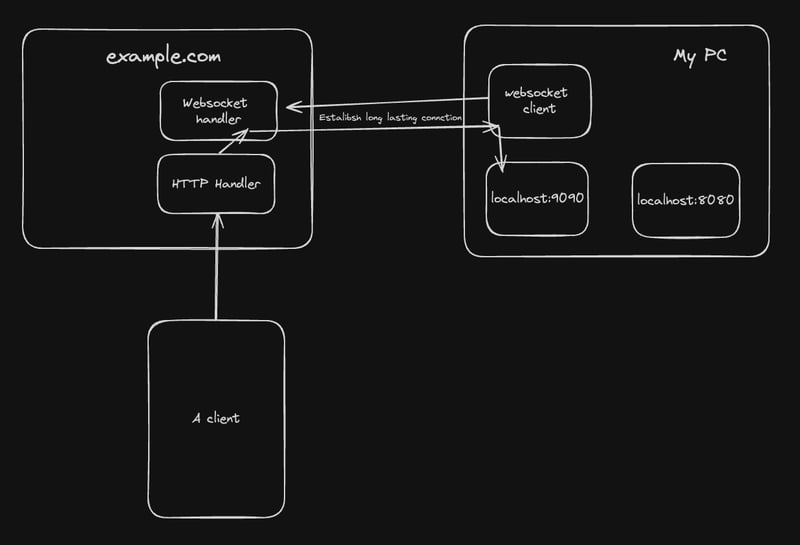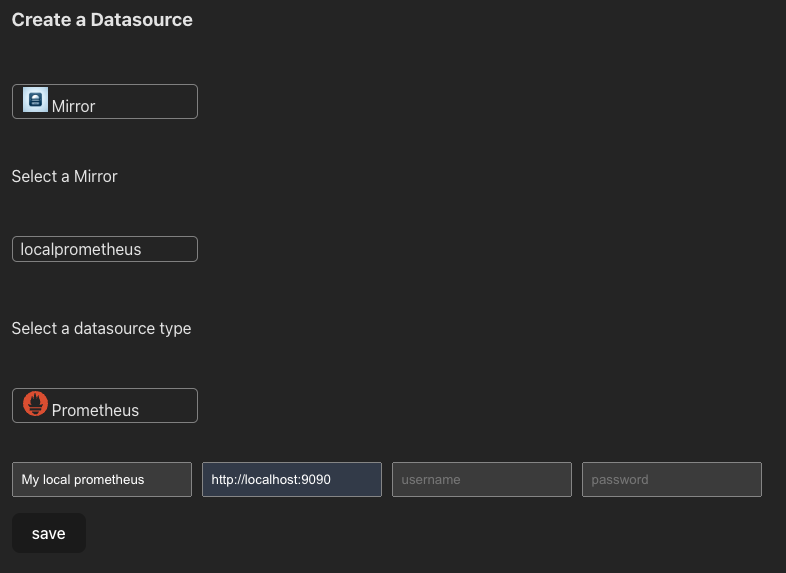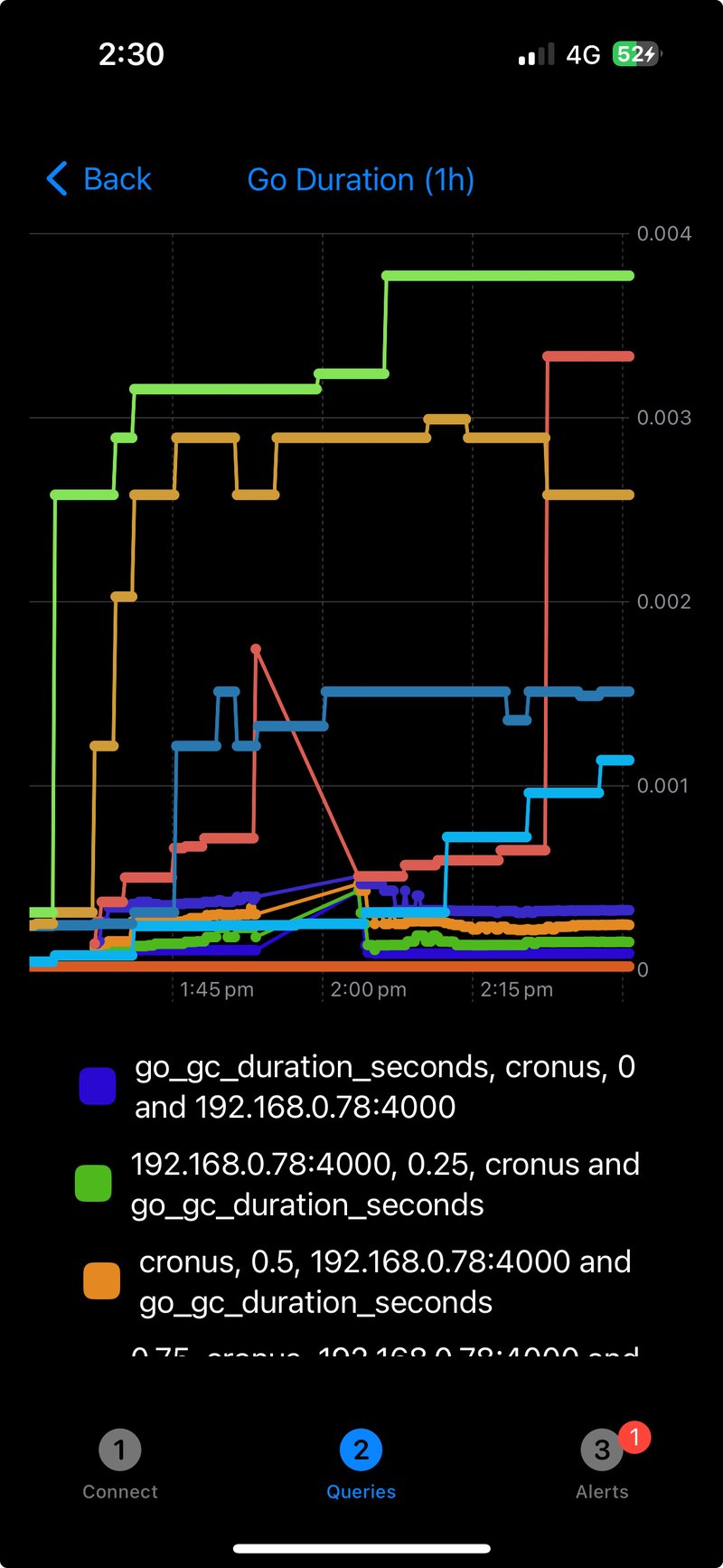Connecting local apps to remote servers. An advance Go guide.

Mat
Posted on February 25, 2024
This guide will show how I created a system that allows clients (mobiles in this case) to connect to local servers without exposing them to the internet. My exact use case is that I have a website cronusmonitoring.com that brings monitoring and alerting to mobile devices.
A major limitation with my service so far is that if a user wants to connect their prometheus server, they would need to expose it over the internet so Cronus can communicate with it.
This guide will be using the following software I have created
Enough rambling. Lets get started.
What do we need to get started
- Some software that runs on a user's computer that forwards requests to the desired datasource
- This software should establish a long lasting websocket with the server
- The client, the Cronus mobile app reaches out to my server over HTTPS. These requests need to be translated and forwarded to the websocket.
Creating magicmirror
Establishing a connection to a websocket on a server
uRemote, err := url.Parse(remote)
if err != nil {
log.Fatalf("Failed to parse remote URL: %v", err)
}
dialer := websocket.Dialer{HandshakeTimeout: 45 * time.Second}
header := make(http.Header)
if apikey != "" {
header.Set("Authorization", fmt.Sprintf("Bearer %s", apikey))
}
connectionURL := fmt.Sprintf("%s?name=%s", uRemote.String(), name)
conn, res, err := dialer.Dial(connectionURL, header)
if res != nil && res.StatusCode != http.StatusSwitchingProtocols {
msg, err := io.ReadAll(res.Body)
if err != nil {
msg = []byte("")
}
log.Fatalf("failed to connect to remote host: %v. response code %v with response \n%v", remote, res.Status, string(msg))
}
if err != nil {
log.Errorf("Failed to connect to remote host: %v %v. Retrying...", remote, err)
return false
}
defer conn.Close()
We need to encode and decode requests and responses. I've omitted the code for brevity, But what we are achieving is base64 encoding the following objects.
type EncodedRequest struct {
Method string `json:"method"`
Uri string `json:"uri"`
Body []byte `json:"body"`
Headers map[string][]string `json:"headers"`
}
type EncodedResponse struct {
Body []byte `json:"body"`
Headers map[string][]string `json:"headers"`
StatusCode int `json:"status_code"`
}
Now that we can decode messages into a request object. We can make that request.
// handleMessage takes a base64 encoded message, decodes it, and makes a HTTP request.
func HandleMessage(encoded []byte, local string) (string, error) {
req, err := messages.DecodeRequest(encoded, local)
if err != nil {
return "", err
}
// Make the HTTP request using http.Client
client := &http.Client{}
response, err := client.Do(req)
if err != nil {
return "", fmt.Errorf("error making HTTP request: %v", err)
}
resp, err := messages.EncodeResponse(response)
return resp, err
}
Finally, we can encode the response and send it back to the server.
_, message, err := conn.ReadMessage()
if err != nil {
log.Errorf("Error reading message: %v. Attempting to reconnect...", err)
return false
}
resp, err := HandleMessage(message, local)
if err != nil {
log.Errorf("Error handling message: %v", err)
failedRead++
continue
}
err = conn.WriteMessage(websocket.TextMessage, []byte(resp))
if err != nil {
log.Errorf("Error writing message: %v", err)
}
magicmirror is now created, The link at the top will show the full source code for it.
Updating the Server to forward requests to magicmirror
First of all, we need to handle creating the connection. Using socketmanager we accept inbound connections and then store the connection in socketmanager. Once again i've omitted most of the code.
func WSMirrorHandler(w http.ResponseWriter, r *http.Request, upgrader websocket.Upgrader) {
sm, err := socketmanager.GetSocketManagerFromContext(r.Context())
...
// what the user calls the connection
name := r.URL.Query().Get("name")
conn, _ := upgrader.Upgrade(w, r, nil)
...
uid := fmt.Sprintf("%s-%s", userid, name)
// adding the connection to socketmanager
sm.Add(uid, name)
sm.SetArb(uid, constants.MIRROR_CONNECTION, conn)
}
Now we need to forward HTTP requests to the connection. I have an endpoint that users query and returns data. In this endpoint we'll update it to forward those requests to magicmirror.
Extracting the connection from socketmanager
func GetSocketConnection(sm *socketmanager.SimpleSocketManager, id string, name string) (*websocket.Conn, error) {
uid := fmt.Sprintf("%s-%s", id, name)
arb := sm.GetArb(uid, constants.MIRROR_CONNECTION)
if arb.Err != nil {
return nil, arb.Err
}
conn := arb.Value.(*websocket.Conn)
return conn, nil
}
Now we can use the connection to make requests
func FetchMirrorData(sm *socketmanager.SimpleSocketManager, req *http.Request, id string, name string) (*http.Response, error) {
conn, err := GetSocketConnection(sm, id, name)
if err != nil {
return nil, err
}
encoded, err := encoder.EncodeRequest(req)
if err != nil {
return nil, err
}
conn.WriteMessage(1, []byte(encoded))
_, msg, err := conn.ReadMessage()
if err != nil {
return nil, fmt.Errorf("failed to read connection error %v", err)
}
resp, err := encoder.DecodeResponse(string(msg))
if err != nil {
return nil, fmt.Errorf("failed to read connection message %v", err)
}
return resp, nil
}
Finally, for the server, lets add a cleanup function to remove inactive sockets from socketmanager
func MirrorHeartBeat(ctx context.Context, dur time.Duration) {
for {
sm, err := socketmanager.GetSocketManagerFromContext(ctx)
if err != nil {
log.Errorf("mirror heartbeat failed %v", err)
time.Sleep(dur)
continue
}
active := GetActiveMirrors(sm)
for i := range active {
arb := sm.GetArb(active[i], constants.MIRROR_CONNECTION)
if arb.Err != nil {
continue
}
conn := arb.Value.(*websocket.Conn)
err := conn.WriteMessage(websocket.PingMessage, []byte{})
if err != nil {
sm.Remove(active[i])
}
}
time.Sleep(dur)
}
}
The code is done. Time to connect
Establishing a connection from my local computer to cronusmonitoring.com
docker run mattyp123/magicmirror --remote wss://cronusmonitoring.com/mirror --apikey <INSERT> --name localprometheus --local http://192.168.0.78:9090
Now we can select it as a datasource
And then run queries against it
And finally, we can view it on the app
Thanks for reading!

Posted on February 25, 2024
Join Our Newsletter. No Spam, Only the good stuff.
Sign up to receive the latest update from our blog.
Related

September 19, 2024




